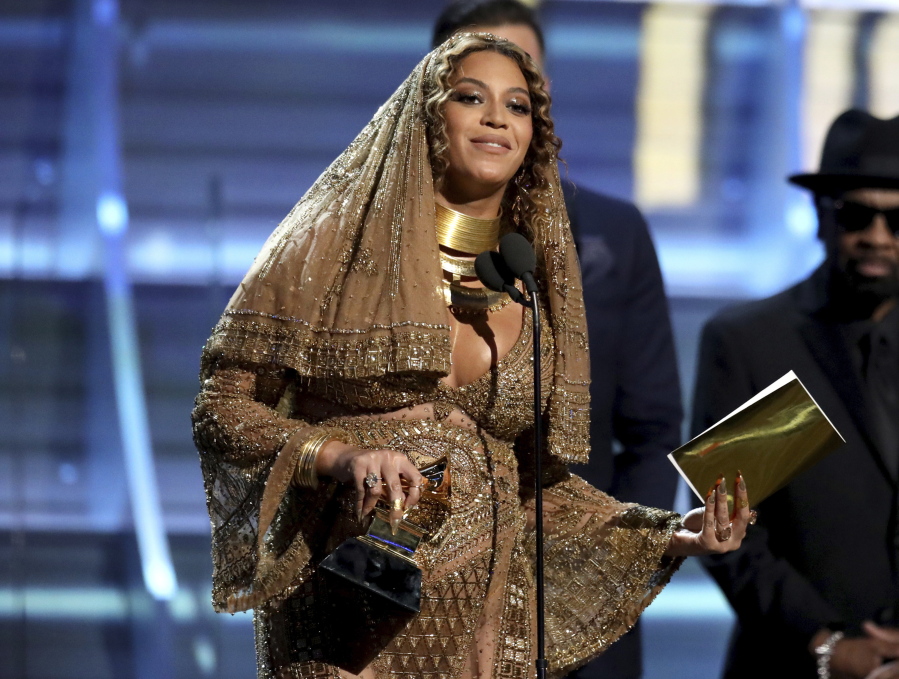She emerged onstage at the Grammys on Sunday wearing little more than her pregnant belly, a statement in itself, even for Beyonce, as society continues to grapple with what maternity looks like for working women.
“They never showed my pregnant belly when I sang my nominated ‘Save the Best for Last,’ ” Vanessa Williams tweeted, referring to her 1993 Grammy performance in a far more modest black billowing dress. “Oh how times have changed! Kudos Beyonce!”
Her proudly and prominently displayed pregnancy wasn’t Beyonce’s only nod to maternal empowerment, however. Ebbing between live shots of the singer standing on stage were pre-recorded projections of Beyonce with her mother, Tina Lawson, who introduced her performance, and her 5-year-old daughter, Blue Ivy — three generations adorned in yellow.
The whole lady lovefest lasted nearly 10 minutes and featured a fully flanked female cast, Beyonce portrayed as the Virgin Mary (and possibly Jesus?) and some creatively precarious chair choreography.
It was described as “ethereal,” a “sci-fi fertility ritual” and just plain “weird.”
But what those unfamiliar with her Grammy-nominated album “Lemonade” may have missed was that the gold and glitz on display were serving a greater purpose.
Beyonce was teaching.
As in “Lemonade” and her pregnancy announcement photos released earlier this month, the singer’s Grammy performance was packed with artistic nods to African, Hindu and Roman goddesses who signify the womanhood Beyonce has been reflecting in her most recent work.
It was a projection image of Beyonce that first appeared Sunday night, the singer barefoot and dressed in a gold string bikini, a long yellow-gold silk drape behind her — as if she were in water, like in the early scenes of her visual album and in her maternity photos.
This is a nod to the African water spirit Mami Wata, or Mother Water, who is often portrayed as half-human and half-fish with long, flowing hair, according to Smithsonian magazine.
Perhaps more obvious, though, is her embodiment of Oshun, a Yoruba water goddess of “female sensuality, love and fertility,” PBS reported when “Lemonade” first dropped last year. Oshun, also spelled Osun, is the love goddess of the Yoruba people, who inhabit the southwestern region of what is now modern day Nigeria and the southern part of Benin, according to Ancient Origins, and is often depicted wearing yellow and surrounded by fresh water.
Oshun reigns over the waters of the Osun Sacred Grove in Nigeria, a UNESCO World Heritage site nestled in a dense forest on the outskirts of the city of Osogbo.
Worshipers come to the grove with offerings and prayers.
“When you come here and tell Osun ‘I am looking for a baby,’ you get a baby; ‘I’m looking for a husband,’ you get a husband; ‘I am looking for money,’ you get money,” priestess Osafunke Iworo Oshun told CNN last year. “Whatever someone asks, Osun will always give the person because it’s important for the society.”
Beyonce also appeared as Oshun in “Hold Up,” the second single on her album. In that video, she wears a flowing yellow dress and emerges from behind two large golden doors amid a wave of water.
Amy Yeboah, an associate professor of Africana studies at Howard University, told PBS that in “Hold Up,” the visual storytelling is as important as the lyrics.
Beyonce is, Yeboah said, “reflecting the power of women spiritually.”
“She takes it deeper into African spirituality,” Yeboah told PBS. “We see this in the first of two baptisms and her emergence as an orisha.”
Artistic representations show Oshun draped in yellow and wearing a gold headpiece.
The gold headpiece Beyone? wears with the bikini appeared during the live segments of her Grammy performance as well, and at one point her dancers draped the reappearing long silk cloth over the crown and extended the ends away from the singer’s body, a tribute to the many-armed Hindu goddess Kali, who is associated with death, sexuality and motherly love.



